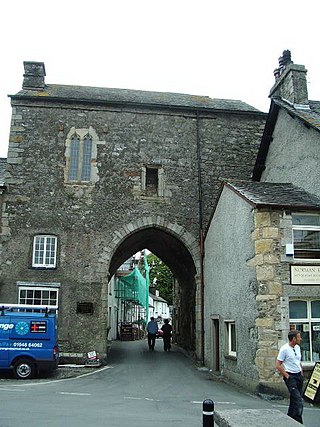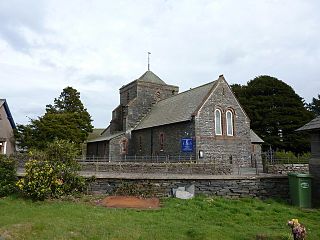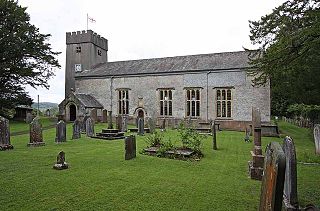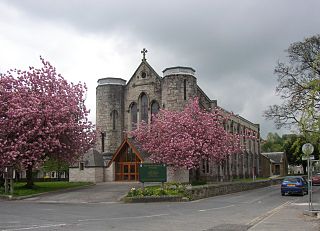
Worcester Cathedral, formally the Cathedral Church of Christ and Blessed Mary the Virgin, is a Church of England cathedral in Worcester, England. The cathedral is the seat of the bishop of Worcester and is the mother church of the diocese of Worcester; it is administered by its dean and chapter. The cathedral is a grade I listed building and part of a scheduled monument.

Cartmel is a village in Cumbria, England, 2+1⁄4 miles northwest of Grange-over-Sands close to the River Eea. The village takes its name from the Cartmel Peninsula, and was historically known as Kirkby in Cartmel. The village is the location of the 12th-century Cartmel Priory, around which it initially grew. Situated in the historic county of Lancashire, since 1974 Cartmel has been part of the ceremonial county of Cumbria.

Carlisle Cathedral is a Grade I listed Anglican cathedral in the city of Carlisle, Cumbria, England. It was founded as an Augustinian priory and became a cathedral in 1133. It is also the seat of the Bishop of Carlisle.

Cartmel Priory Gatehouse is a medieval building located at Cartmel, Grange-over-Sands, Cumbria, England. It is listed Grade II* and is part of a scheduled monument. It belongs to the National Trust.

Lancaster Priory, formally the Priory Church of St Mary, is the Church of England parish church of the city of Lancaster, Lancashire, England. It is located near Lancaster Castle and since 1953 has been designated a Grade I listed building. It is in the deanery of Lancaster, the archdeaconry of Lancaster and the Diocese of Blackburn. Its benefice is combined with that of St John and St Anne.

St Bees Priory is the parish church of St Bees, Cumbria, in England. There is evidence for a pre-Norman religious site, and on this a Benedictine priory was founded by the first Norman Lord of Egremont William Meschin, and was dedicated by Archbishop Thurstan of York, sometime between 1120 and 1135.

St Patrick's Church is the parish church of Preston Patrick, Cumbria, England. It is an active Anglican church, one of eight parish churches served by the Kirkby Lonsdale Team Ministry. It is in the archdeaconry of Westmorland and Furness, and the diocese of Carlisle. The church is recorded in the National Heritage List for England as a designated Grade II listed building.

St Paul's Church is in Crown Hill, Grange-over-Sands, Cumbria, England. It is an active Anglican parish church in the deanery of Windermere, the archdeaconry of Westmorland and Furness, and the diocese of Carlisle. Its benefice is united with those of St Mary, Allithwiate, St Mary and St Michael, Cartmel, St Peter, Field Broughton, St John the Baptist, Flookburgh, Grange Fell Church, Grange-Over-Sands, and St Paul, Lindale, to form the benefice of Cartmel Peninsula. The church is recorded in the National Heritage List for England as a designated Grade II listed building.

St Mary's Church is in the village of Allithwaite, Cumbria, England. It is an active Anglican parish church in the deanery of Windermere, the archdeacon of Westmorland and Furness, and the diocese of Carlisle. Its benefice is united with those of St Mary and St Michael, Cartmel, St Peter, Field Broughton, St John the Baptist, Flookburgh, St Paul, Grange-over-Sands, Grange Fell Church, Grange-Over-Sands, and St Paul, Lindale to form the benefice of Cartmel Peninsula. The church is recorded in the National Heritage List for England as a designated Grade II listed building.

St Peter's Church is in the village of Finsthwaite, Cumbria, England. It is an active Anglican parish church in the deanery of Windermere, the archdeaconry of Westmorland and Furness, and the diocese of Carlisle. Formerly part of the Leven Valley benefice, together with St Anne Haverthwaite and St Mary Staveley-in-Cartmel, it is now part of the Cartmel Peninsula Team Ministry. The church is recorded in the National Heritage List for England as a designated Grade II* listed building. St Peter's was designed by the Lancaster partnership of Paley and Austin. They were the winners of a competition to design "mountain chapels" organised by the Carlisle Church Extension Society in 1873. The authors of the Buildings of England series describe the church as "a brilliant essay", and write that "one would have to search far and search long in England to find village churches to vie with" this and two other Austin and Paley churches, Torver and Dolphinholme. The church stands to the southeast of the village.

Ulverston Parish Church is in Church Walk, Ulverston, Cumbria, England. It is an active Anglican parish church in the deanery of Furness, the archdeaconry of Westmorland and Furness, and the diocese of Carlisle. Its benefice is united with that of St John, Osmotherley. The church is recorded in the National Heritage List for England as a designated Grade II* listed building.

St Martin's Church stands in the centre of the town of Bowness-on-Windermere, Cumbria, England. It is an active Anglican parish church in the deanery of Windermere, the archdeaconry of Westmorland and Furness, and the diocese of Carlisle. The church is recorded in the National Heritage List for England as a designated Grade I listed building. Its benefice is united with that of St Anne's Church, Ings; St Cuthbert's Church, Kentmere; St James' Church, Staveley; Jesus Church, Troutbeck and St Mary's Church, Windermere.

St Mary's Church is in the town of Dalton-in-Furness, Cumbria, England. It is an active Anglican parish church in the deanery of Furness, the archdeaconry of Westmorland and Furness, and the diocese of Carlisle. Its benefice has been combined with that of St Peter, Ireleth-with-Askam. The church is recorded in the National Heritage List for England as a designated Grade II* listed building. It stands in an elevated position near Dalton Castle.

St Luke's Church is in the village of Torver, Cumbria, England. It is an active Anglican parish church in the deanery of Furness, the archdeaconry of Westmorland and Furness, and the diocese of Carlisle. The church is recorded in the National Heritage List for England as a designated Grade II listed building.

St Paul's Church is in the village of Witherslack, Cumbria, England. It is an active Anglican parish church in the deanery of Kendal, the archdeaconry of Westmorland and Furness, and the diocese of Carlisle. It is recorded in the National Heritage List for England as a designated Grade II* listed building. The authors of the Buildings of England series describe it as "an almost perfect example of a plain Gothic church of that date, honest and unpretentious".

St Peter's Church is in the village of Field Broughton, Cumbria, England. It is an active Anglican parish church in the deanery of Windermere, the archdeaconry of Westmorland and Furness, and the diocese of Carlisle. Its benefice is united with those of St Mary, Allithwiate, St Mary and St Michael, Cartmel, St John the Baptist, Flookburgh, St Paul, Grange-over-Sands, Grange Fell Church, Grange-Over-Sands, and St Paul, Lindale, to form the benefice of Cartmel Peninsula. The church is recorded in the National Heritage List for England as a designated Grade II* listed building.

St John the Baptist's Church is in Station Road in the village of Flookburgh, on the Cartmel Peninsula in Cumbria, England. It is an active Anglican parish church in the deanery of Windermere, the archdeaconry of Westmorland and Furness, and the diocese of Carlisle. Its benefice is united with those of St Mary, Allithwaite, St Mary and St Michael, Cartmel, St Peter, Field Broughton, St Paul, Grange-over-Sands, Grange Fell Church, Grange-Over-Sands, St Paul, Lindale, St Mary Staveley-in-Cartmel, St Anne Haverthwaite and St Peter Finsthwaite to form the benefice of Cartmel Peninsula. The church is recorded in the National Heritage List for England as a designated Grade II* listed building.

St George's Church is in Castle Street, Kendal, Cumbria, England. It is an active Anglican parish church in the deanery of Kendal, the archdeaconry of Westmorland and Furness, and the diocese of Carlisle. Its benefice is united with those of St Oswald, Burneside, St John, Grayrigg, St Mary, Longsleddale, St Thomas, Selside, and St John the Baptist, Skelsmergh, to form the Beacon Team Mission Community. It was a Commissioners' church, having received a grant towards its construction from the Church Building Commission.

St Mary's Church is in the village of Staveley-in-Cartmel, Cumbria, England. It is an active Anglican parish church in the deanery of Windermere, the archdeaconry of Westmorland and Furness, and the diocese of Carlisle. It is recorded in the National Heritage List for England as a designated Grade II listed building.

St Michael's Church is in the village of Pennington, Cumbria, England. It is an active Anglican parish church in the deanery of Furness, the archdeaconry of Westmorland and Furness, and the diocese of Carlisle. Its benefice is united with those of Holy Trinity, Bardsea, and St Peter, Lindal and Marton. The church is recorded in the National Heritage List for England as a designated Grade II listed building.



























